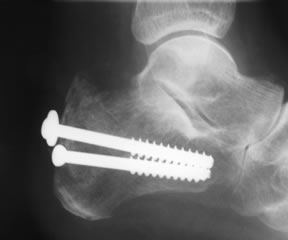

Originally described by Lenormant and Wilmoth in 1932 and popularised by Palmer(1948). ORIF was intermittently popular throughout the 1950s and 60s but fell out of favour. Improvements in imaging, internal fixation technique, surgical approach and soft tissue management contributed to a revival of popularity.
Does surgery improve the outcome?
There are four randomised controlled trials in intra-articular calcaneal fractures. Parmar et al (1988) used a minimal fixation technique with two lag screws to posterior the subtalar joint only, and found no difference in outcome between surgical and non-surgical groups. O’Farrell (1993) and Thordarson ( ) used open reduction and lateral plating in small trials of 24 and 26 patients. Both found small but significant improvements in the surgical groups: O’Farrell in heel size, return to work and walking distance, Thordarson in AOFAS hindfoot scores.
Buckley et al (2002) reported one of the largest trials undertaken in foot and ankle trauma. 424 patients were randomised to ORIF through an extended lateral incision using lag screws and lateral plating, or to functional non-surgical treatment. There were no significant difference between the groups in SF36 or visual analogue satisfaction scores. However, some groups did better than average:
Non-operatively treated patients were five times as likely to undergo subtalar fusion but the final results of this were not presented. A subsequent paper suggests that initial treatment did not affect the final outcome of subtalar fusion – in other words, failures of non-surgical treatment can be effectively salvaged.
 |
 |
| ORIF of a calcaneal fracture through the lateral approach using lag screws to compress subtalar joint fragments and a lateral buttress plate to support the comminuted lateral wall | |
There is a place for surgery in patients with favourable features. Careful patient selection and counselling are important.
In addition, patients with open fractures will require debridement and it may be thought best to reconstruct at the same time.
All the trials used a lateral approach with varied fixation techniques, but did not examine the effect of technique on outcome. Some information about technical aspects is available from case series.
Medial or lateral approach?
Palmer used a lateral approach along the line of the peroneal tendon sheath. The sheath is opened and the tendons displaced anterior to the malleolus. The sural nerve may be retracted in either flap. This may cause problems with access, peroneal tendon adhesions or sural nerve injuries. Palmer reported 90% good results, but subsequent results have been variable (Rowe, Hazlett 1969, Letournel 1993).
Problems with wound healing, access and peroneal tendon adhesions have led modern surgeons to turn to an extended lateral incision (Eastwood et al) which runs down the lateral border of the tendo Achilles to the point of the heel, then directly forward to the calcaneocuboid joint or further. The flap is elevated subperiosteally and the peroneal tendon sheaths are not opened. The sural nerve is protected in the anterior flap. The lateral approaches have been preferred by most surgeons because it is felt that the key to stabilisation of the fracture is control of the lateral wall burst fracture.
McReynolds and Burdeaux emphasise reduction of the sustentacular fragment to the body, and believe that all necessary reduction can be done through the medial approach posterior to the neurovascular bundle, only reducing the lateral wall in a few comminuted fractures, those in which reduction of the joint could not be accomplished from the medial side, and calcaneo-cuboid joint fractures. Using this technique, McReynolds reported 78% good or excellent results in 108 fractures. Zwipp et al obtained only 50% good results with this approach, improving to 78% with a bilateral approach.
Most authors accept that a bilateral approach is sometimes necessary. Stephenson (1987) adopted this technique routinely and reported that 86% of fractures were congruently reduced and 77% got good results.
To graft or not to graft?
Palmer used iliac bone graft for stabilisation. Subsequent authors have used graft to supplement varying amounts of internal fixation. However, many authors do not graft, as the cancellous bone of the os calcis regenerates within 8 weeks (Stephenson 1987). Longino et al (2001) carried out a matched cohort study and found no difference in quality or maintenance of reduction in grafted or non-grafted patients.
 |
|---|
| Avulsion fracture of Achilles insertion fixed with percutaneous screws |
ORIF is occasionally indicated for non-articular fractures. Fractures involving the Achilles tendon insertion are usually displaced by the tendon pull and are best fixed to reattach the tendon. Early movement may be possible, perhaps using a similar regime to that after Achilles tendon repair, provided bone stock is adequate.